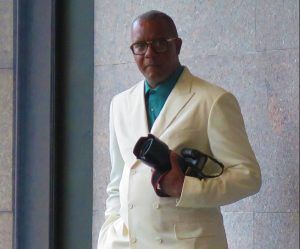
Jamel Shabazz: Freezing time and motion with his camera

Visually documenting hip hop’s history is a task Jamel Shabazz took on as the genre began flourishing globally during the 1980s. As a social historian, he knew the importance of doing so early on prior to Corporate America getting its claws involved. Growing up in Brooklyn’s Red Hook Projects during the 1960s and ’70s, he was greatly influenced by the Black Power and Civil Rights Movements prevalent then.
“With the gift comes the responsibility to do some good,” he notes. “I picked up the camera and acquired knowledge-of-self around the same time. Doing work that’s meaningful is important. Having knowledge-o-self gave me a sense of direction and my camera was my compass, making sure our history is preserved.”
Inspired by his father, who was also a photographer, he began shooting at age 15. “He laid down the foundation and possessed a vast library of these incredible books that gave me a gateway to the world,” he explains. “Album covers introduced me to another aspect of photography.”
He recalled witnessing urban creativity in the 700s, being influenced by Gil Scott Heron, The Last Poets, and various magazines. “The photographs helped me develop a love for photography.”
While in the military in the early ’80s, he became aware of the Black Arts Movement. “It helped me understand the importance art and culture held in uplifting people. I want to inspire others.”
He mentions photographer Leonard Freed’s book “Black in White America” as an early inspiration, before explaining his process.
“What took place before the photo was the conversations about life, then we move forward,” he explains. “It was about my journey, it’s about engagement, it was about offering enlightenment.”
Going down memory lane: “The Supreme Team was the first time I heard hip hop on the radio, early ’80s. Melle Mel’s ‘The Message’ stood out.”
Due to his interest in Black socializing, he parlayed that into his work. “KRS’ ‘Self Destruction’ video, that’s when I saw the true power of hip hop. Also, Dr. Dre’s ‘We’re All in the Same Gang.’ They all came together to address the problems in our community.”
Shabazz recalled a late ’80s event in Chicago as his initial hip hop assignment, capturing Public Enemy, Queen Latifah, Big Daddy Kane, and MC Shan, and also credits an 1988 homeless drive at Harlem’s Apollo Theater. “That’s really the first time I saw artists use their platform to address social issues.”
His photos have appeared in popular journals like The Source, Trace, One World, and Vibe
“It was really the hip hop publications that gave me my foundation and helped me build an international fan base,” Jamel contends.
One of his highlights is when Dave Chapelle asked him personally to document his 2004 “Block Party.” “It was one of my greatest musical moments,” he says before mentioning LL, Guru, Yasim Bey and The Roots, among his favorites. “There’s so many.”
Along with “Back In The Day”, and “A Time Before Crack,” he has 10 other books and has been featured in several documentaries.
“Photographers are very conscious people because we see things. As artists we must use our position to make the world a better place. We need the voice of these young rappers addressing social issues. We need the consciousness to come back into the music.”
Currently Shabazz has two exhibitions: “Albums” at the Gordon Parks Foundation in Pleasantville, NY, running through July, and “Faces and Places” at the Brooklyn Museum til Sept. 22
Follow him on IG at @jamelshabazz.
The post Jamel Shabazz: Freezing time and motion with his camera appeared first on New York Amsterdam News.